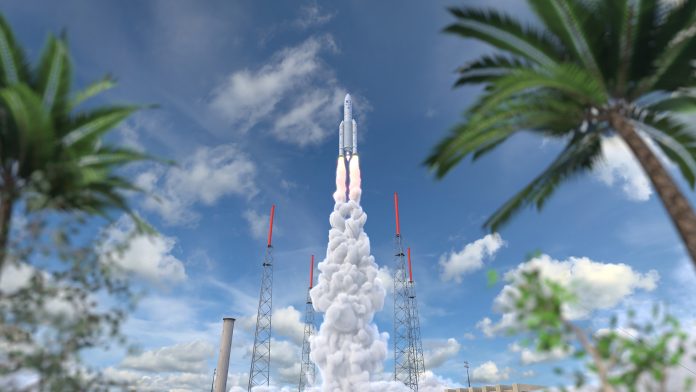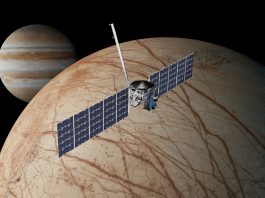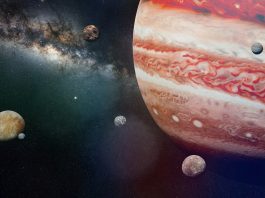Ignacio Tanco, JUICE Spacecraft Operations Manager at European Space Agency, discusses the vast discovery potential of the JUICE mission as it prepares for launch.
Set to launch in April 2023, the European Space Agency’s (ESA) Jupiter Icy Moons Explorer – known as JUICE – will make detailed observations of the giant gas planet and its three large ocean-bearing moons – Ganymede, Callisto and Europa – with a suite of remote sensing, geophysical and in situ instruments. The JUICE mission will characterise these moons as both planetary objects and possible habitats, explore Jupiter’s complex environment in depth, and study the wider Jupiter system as an archetype for gas giants across the Universe.
Following a lengthy development process, JUICE has now arrived at Europe’s Spaceport in French Guiana where it is undergoing final preparations before its launch. Following final testing and inspection, the spacecraft will be fuelled up and mounted on an Ariane 5 rocket. The launch will be the start of an eight-year voyage to Jupiter, where it will arrive in 2031.
Ahead of the launch, Editor Georgie Purcell spoke to Ignacio Tanco, JUICE Spacecraft Operations Manager at ESA, to determine the logistics, challenges and great potential of such a monumental mission.
Can you provide an overview of the preparation for the JUICE mission? How long has it taken?
The JUICE mission is now in the later stages of the development process. It was approved in 2014 and has been running for some time. The timescale has followed a fairly typical trajectory for a mission of these characteristics and this size. It is a lengthy process as it takes time to collate contracts, develop the instruments, and to organise everything.
As Spacecraft Operations Manager, my operations team joined the process at a relatively late stage. We have been working at the European Space Operations Centre (ESOC) on the mission for around the past four years. Before that, we were following the design of the spacecraft on a part-time basis whilst also operating other missions.
We are now at the very end of the development process. The spacecraft has been built and we are on a countdown to launch in April of this year.
What is it hoped the mission will achieve?
JUICE is a very challenging mission, but we are hoping to achieve a lot. In terms of science, it is an extremely interesting mission as it goes to Jupiter to study, in detail, the three icy moons, which are objects of very high interest for the science that can be conducted there. The mission will perform a detailed survey of the Jovian system, which encompasses not only the icy moons but Jupiter and its moons as a whole. Whilst it will not necessarily be the first mission to do this, and it will do so in co-ordination with other missions that will be operating in Jupiter at that time, it will be the first to do several things.
JUICE will be the first mission to orbit a moon in a different planet. This brings with it a number of engineering challenges that we will have to achieve. This involves being the first mission to perform a double orbit insertion first around Jupiter, then around Ganymede. We will have to carry out very complex navigation to get there, which will include several planetary flybys on the way to Jupiter. It is a long mission with a long cruise, taking almost eight years to get there followed by another four years of operating around Jupiter. Whilst we are at Jupiter, we will do around 35 moon flybys before we achieve orbital capture of Ganymede. It will be very interesting and very intense.
What do we already know about Jupiter’s icy moons and what are you hoping to discover?
We know a significant amount so far. The icy moons are objects of such high interest because of what we know already. It is certain that there are very high volumes of water in these three moons. With Europa, Callisto, and Ganymede, all three have an obvious presence of large quantities of ice. In particular, Europa is very smooth on the surface, so there are processes that are most likely tectonic in nature, and this may involve the presence of subsurface oceans. The same can be observed in Ganymede, though perhaps not as clearly. Here, there are areas made out of rock, but other areas are covered with ice which seems relatively new, indicating that there must be a process that renews the presence of this ice on the surface. This circulation may or may not involve the presence of significant quantities of liquid water underneath the surface. They are also called ‘ocean worlds’ because of this. JUICE will help to clarify and determine this with certainty. If there are large quantities of water below the surface, we will help to characterise this and we will also study the composition of these worlds, hoping to detect biomarkers. Whilst these biomarkers will not necessarily be the presence of life, they will indicate the possibility that life could be there.
What further research could the findings lead to?
As I mentioned, the confirmation of the presence of subsurface oceans in these three moons is one of the key objectives of the mission. If there is confirmation that there are large quantities of liquid water, and we also manage to confirm the presence of possible chemical processes that could support life, then the obvious next question is to send probes to perform, in situ, more direct exploration of these environments to see if there has ever been the possibility of life on these moons.

Ignacio Tanco
JUICE Spacecraft Operations Manager
European Space Agency
https://www.esa.int/
https://www.linkedin.com/company/european-space-agency/
https://www.facebook.com/EuropeanSpaceAgency
https://twitter.com/esa
Please note, this article will also appear in the thirteenth edition of our quarterly publication.









